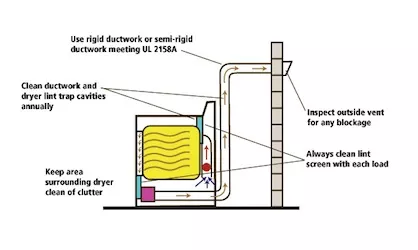Dryer Vent Safety Guide
Excess lint in your dryer and dryer venting builds up slowly and gradually – you don’t even realize it’s happening. Many homeowners think that by cleaning out the lint filter after each load that you are doing your job of maintaining your dryer. This is not the case! Cleaning out the lint filter is a very important part of dryer maintenance but to insure the safety of your family and home you need to clean out the drying venting as well.
A full load of wet clothes contains about a half gallon of water. Lint is created from the clothes as the water is removed during the drying process. This lint will build up in the crevices deep down inside the lint filter trap, and all along the dryer vent hose. When your lint filter becomes plugged, it restricts the outflow of heated air, which can cause your dryer to become overheated. As a result of this build up, your dryer is the # 1 source of fire in your home. Importance of cleaning the lint filter. Cleaning the lint filter after each load should be part of your regular maintenance on your dryer.
- Insures optimum performance
- Reduces risk of fire in your home
- Cleaning the lint filter saves you money. Lint build-up in your dryer causes it to work longer and harder to dry your clothes, using more energy and costing you more money on your utility bills.
Warning signs that you have dangerous lint build-up.
-
- Clothes won’t fully dry
- Clothes take longer and longer to dry
- Clothes are hotter than normal after a drying cycle
- The outside of the dryer gets very hot
- The outside exhaust vent flapper does not open very much. This indicates low exhaust velocity.

- Laundry room is feels humid than it usually does
- A burnt smell is noticeable in the laundry room
Prevention Tips
- Fires originate most often from two places, dryer venting and the lint trap/filter.
- Know where your lint filter is and clean it out after every load of laundry you do.
- Vacuum the lint trap housing cavity monthly.
- Clean behind the dryer where lint can build up.
- Check the outside dryer vent while the dryer is operating to make sure exhaust is escaping. You should feel a strong discharge of moist air. If you do not have a strong discharge of air you may have a blockage in the exhaust path and need to disconnect the ducting and inspect it for blockage.
- Keep the area around the dryer clean and free of clutter.
- Once every couple years, have a qualified service person clean the interior of the dryer structure to minimize the amount of lint accumulation.
- Make sure to replace any plastic or metal foil, accordion-type ducting material as plastic is not approved for dryer use and some metal foil ducts may not be approved either. Only use flexible ductwork meeting UL 2158A for dryer venting.
- Gas and LP fired driers require metal venting not plastic venting due to the potential for cabon monixide poisoning.
- Take special care when laundering clothes containing VOC’s (volatile organic compound), such as gasoline, cooking oils, cleaning agents, or finishing oils or stains. Wash heavily soiled clothing more than once to minimize the amount of volatile chemicals on clothes and if possible, hang to dry. If you have to use the dryer, use the lowest heat setting and a dry cycle with a cool down period. To prevent clothes from igniting after drying, do not leave the dried clothes in the dryer or piled in a laundry basket.
**Special Warnings
- Electric dryers are 2.5 times more likely to be the cause of fire than gas dryers. This is due to the higher heat discharge from an electric dryer that exacerbates the lint buildup problem.
- Even though the lint has been removed and the filter appears to be clean, certain fabric sheets used in the drying cycle, can cause a thin clear film to develop on the filter, forming a barrier which restricts the air from properly exhausting from your dryer. A quick test to see whether this film exists, is to take your filter to a sink and run water into it, while observing whether the flow can easily pass through the mesh, or just pools in the filter. If the flow is unable to pass through – a thorough filter cleaning is required. Use a very soft nylon brush and warm soapy water to clean your filter, and repeat the above test – the flow should no longer be restricted. Repeat this cleaning every six months.
These helpful tips will keep your family safe from a dangerous fire hazard, insure that your dryer continues to work at its optimal capacity, and helps extend the life of your dryer.
Sidebar
Northeast Ohio
Neighbors We are committed to bringing our
community fast, affordable home
comfort solutions.





